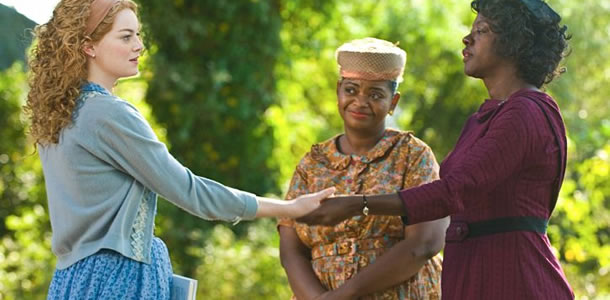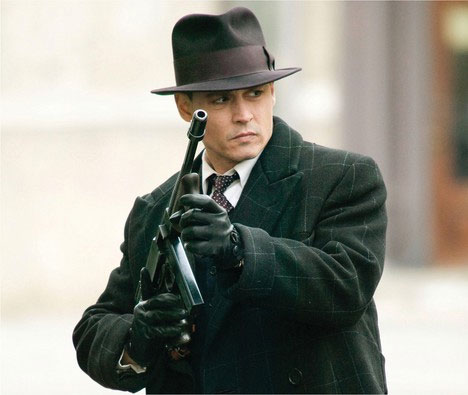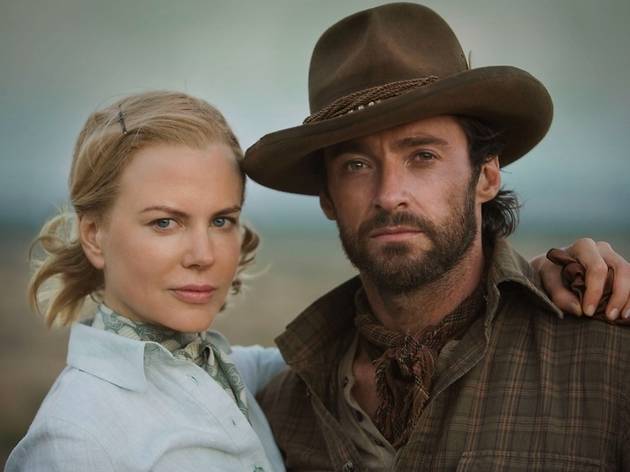J. Edgar (2011)
DIRECTOR: Clint Eastwood
CAST:
Leonardo DiCaprio, Armie Hammer, Judi Dench, Naomi Watts
REVIEW:
During his forty-eight-year reign as director of the FBI, John Edgar Hoover was regarded by many as the most powerful man in America. Continue reading
The Help (2011)
CAST: Emma Stone, Viola Davis, Octavia Spencer, Jessica Chastain, Bryce Dallas Howard, Allison Janney, Sissy Spacek
REVIEW:
Perhaps the greatest value of The Help, like other films such as 12 Years a Slave or Selma, is in reminding those too young to have first-hand experience of just how oppressive large sections of the United States were to their African-American inhabitants only a few short decades ago. This is not some vague ancient history; people who grew up in the environment depicted onscreen are still alive today. While The Help is not as hard-hitting as the films mentioned above—nor, to be fair, is that really its intention, and at times it outright aims for “feel good”—and is somewhat weakened by a tendency to paint with broad strokes and deal in black-and-white (no pun intended), it’s still a worthy time capsule that is sometimes inspiring, sometimes moving, and sometimes illuminating. Continue reading
X-Men: First Class (2011)
DIRECTOR: Matthew Vaughn
CAST:
James McAvoy, Michael Fassbender, Jennifer Lawrence, Nicholas Hoult, Kevin Bacon, Rose Byrne, January Jones, Caleb Landry Jones, Lucas Till, Edi Gathegi, Zoe Kravitz, Jason Flemyng, Oliver Platt
REVIEW:
Back when he wrote and directed 2000’s X-Men, Bryan Singer eschewed an origin story, jumping into the action with the X-Men already formed, deeming origin stories unnecessary and constraining. A decade later, Singer (who helped develop the story and served as producer here) and director Matthew Vaughn decided to tackle the ‘origin story’ after all, not only of the ‘first class’ of X-Men, but the friends-turned-enemies Charles Xavier/Professor X and Erik Lensherr/Magneto. While 2009’s X-Men Origins: Wolverine failed to do anything interesting with its central character, Vaughn and company have righted that wrong here. First Class is easily ahead of The Last Stand, and might well top out X-Men and X2 for the best installment the series has produced so far. Continue reading
The King’s Speech (2010)

DIRECTOR: Tom Hooper
CAST: Colin Firth, Geoffrey Rush, Helena Bonham Carter, Guy Pearce, Jennifer Ehle, Michael Gambon, Derek Jacobi, Timothy Spall, Claire Bloom
REVIEW:
The King’s Speech from director Tom Hooper and screenwriter David Seidler is proof that the “buddy movie” formula can be applied to things other than cop comedy-dramas, even to a historical docudrama about a decidedly odd couple friendship between King George VI and his speech therapist. To that end, it’s a handsome, stately period historical drama bolstered by strong acting and strong chemistry and the dynamic between two very different men who under different circumstances would never have met.
Continue readingSherlock Holmes (2009)
DIRECTOR: Guy Ritchie
CAST:
Robert Downey Jr., Jude Law, Rachel McAdams, Mark Strong
REVIEW:
Devout followers of Sir Arthur Conan Doyle’s detective novels may be appalled at what director Guy Ritchie has done with Doyle’s creation, but those with open minds may find a surprising amount of Holmesian details emerge intact, and for all others, Sherlock Holmes is a rollicking ride with plenty of action and comedy and some style and wit along the way. Continue reading
Public Enemies (2009)
CAST: Johnny Depp, Christian Bale, Marion Cotillard, Billy Crudup, Stephen Graham, Stephen Lang, Jason Clarke, Stephen Dorff, Giovanni Ribisi, Lili Taylor, David Wenham, Leelee Sobieski, Branka Katic, Channing Tatum
REVIEW:
Public Enemies is not the first film to portray legendary bank robber John Dillinger, but it’s the most high-profile and the most accomplished, but certain elements keep it from gangster genre classic status, not least of which is that director Michael Mann (The Last of the Mohicans, Heat) elects to film the events in docudrama style instead of aiming for grandeur and glamor. It could be argued that Public Enemies is an independent art film masquerading as a gangster epic, and how audiences react to that will determine how absorbed they become by the film’s content. Continue reading
Doubt (2008)
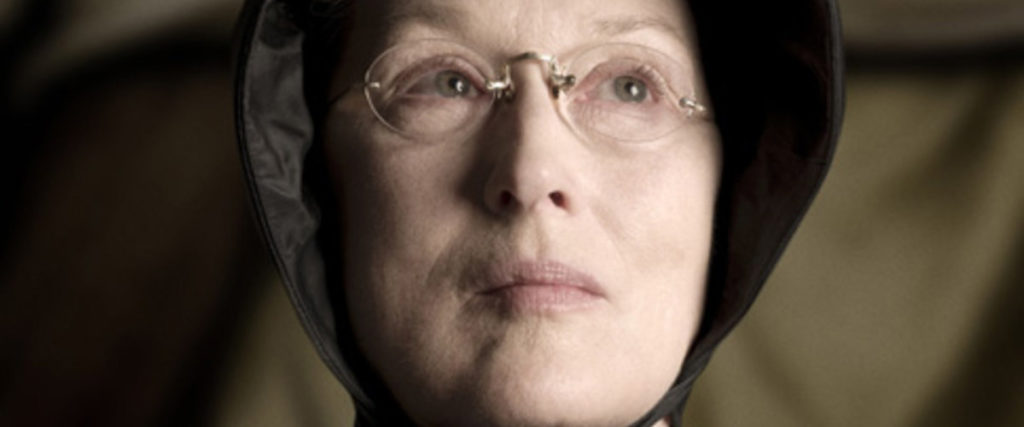 DIRECTOR: John Patrick Shanley
DIRECTOR: John Patrick Shanley
CAST: Meryl Streep, Philip Seymour Hoffman, Amy Adams, Viola Davis
REVIEW:
Doubt, John Patrick Shanley’s film adaptation of his Pulitzer Prize and Tony Award-winning play, deals with various issues—the debate over whether the Catholic Church should stand firm to old-school doctrine or evolve with the times, the ways in which those too wrapped up in their own righteousness lose sight of compassion, more tangential questions of crisis of faith and (perhaps) sexuality—-but primarily it’s a battle between doubt and certainty, both as an external conflict between characters and within individual characters’ hearts. Its outwardly simple, straightforward premise steeps itself in ambiguity and leads us into a moral quagmire from which it never lets us emerge. Those who dislike ambiguity and expect a film to offer a clear-cut resolution with clear answers will not be satisfied. Different viewers will come to different interpretations, and Doubt is the kind of film (or play) that can inspire heated debates after the end credits have rolled or the curtain has fallen. Continue reading
Frost/Nixon (2008)
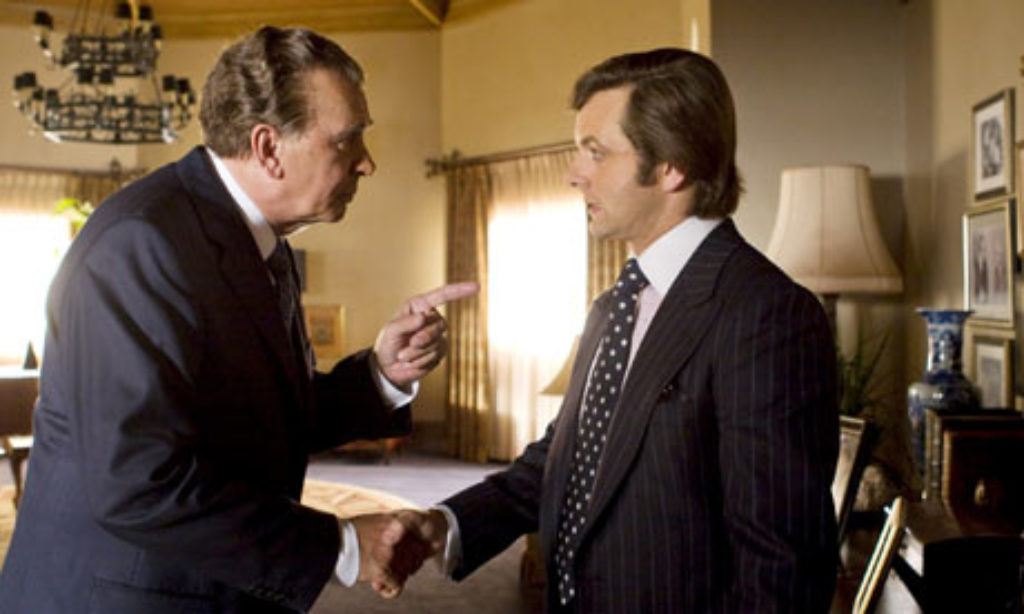
DIRECTOR: Ron Howard
CAST: Michael Sheen, Frank Langella, Kevin Bacon, Sam Rockwell, Oliver Platt, Matthew Macfadyen, Rebecca Hall, Toby Jones
REVIEW:
For the latest entry on an eclectic filmography, Ron Howard has teamed up with playwright/screenwriter Peter Morgan for this film adaptation of Morgan’s own play, a semi-fictionalized docudrama chronicling the 1977 interview pitting British talk-show host David Frost against former President Richard Nixon. To this end, they have managed the impressive accomplishment of turning what could have been a dry, stuffy subject into a powerful and compelling drama and character study, proving that slick cinematic craftsmanship, an intelligent script, and powerhouse acting can take something seemingly mundane—an interview—and make it intensely riveting.
Continue readingAustralia (2008)
CAST: Nicole Kidman, Hugh Jackman, Brandon Walters, David Wenham, Jack Thompson, Bryan Brown, David Ngoombujarra, Ben Mendelsohn, David Gulpilil
REVIEW:
Baz Luhrmann is an unabashed romantic and an equally unapologetic fan of big, grandiose, old-fashioned melodramas, and while Australia, Luhrmann’s simply-titled ode to his homeland, is a little more restrained (relatively speaking) than Moulin Rouge, it contains many of his hallmarks. It’s big, bold, and brash, painted on a sweeping canvas and recalling old 1950s romantic melodramas. Alas, a meandering overlong narrative and uneven tone leave it not having the sweeping effect it strives so hard for. Australia looks great and is not without entertainment value, but an inability to settle into a consistent groove leaves it weighed down by its own grandiose melodrama into a rather campy sudsy romance/adventure that’s as likely to induce eye-rolling as swooning. Continue reading
Indiana Jones and the Kingdom of the Crystal Skull (2008)
DIRECTOR: Steven Spielberg
CAST:
Harrison Ford, Shia LaBeouf, Cate Blanchett, Karen Allen, Ray Winstone, John Hurt, Jim Broadbent
REVIEW:
Indiana Jones and the Kingdom of the Crystal Skull, coming nineteen years after the so-called Last Crusade; nineteen years for fan expectations to climb to levels no film can satisfy. Series writer George Lucas has previously felt the wrath of disappointed fans with his Star Wars prequels sparking (over-the-top) accusations of ruined childhoods, and now he gets to experience it again. Part of it is surely that it’s simply been a very long time since Indiana Jones rode into action, and it is perhaps unfair to expect the new installment to recapture the old magic where it left off. But it’s hard to give Lucas and director Steven Spielberg too much slack, because even all things considered, Indiana Jones and the Kingdom of the Crystal Skull is as unwieldly as its overlong name, the most lifeless entry in the series, overplotted, unevenly paced, and meandering, and feels like a superfluous entry in a series that’s past its prime.
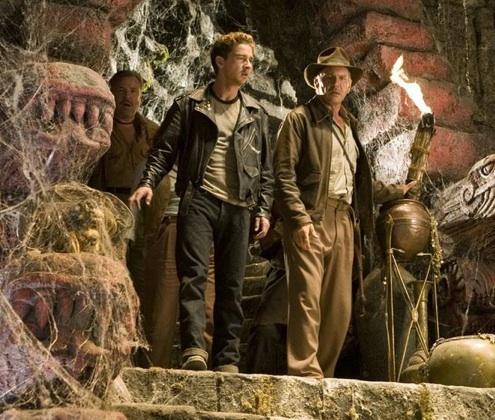 We start with the requisite Indy prologue in 1957 Nevada, where Soviet KGB agents led by Irina Spalko (Cate Blanchett, sporting a tight Soviet uniform, her hair in a black bob cut, an icy expression, and a Russian accent; she never tells Indy ‘ve have vays to make you talk’, but she always seems like she’s about to) have dragged a kidnapped Dr. Jones (Harrison Ford) and his latest sidekick, the unreliable Mac (Ray Winstone), to a secret US army warehouse (the same warehouse where the Ark of the Covenant was stashed away at the end of Raiders). There is something there Spalko wants, and she intends on forcing Indy to find it for her. The item in question turns out to be the legendary Crystal Skull, which she believes has paranormal powers. Apparently Spalko was Stalin’s foremost expert on paranormal studies and believes the skull can be a weapon to tip the scales of the Cold War in the Soviet Union’s favor. Of course this scene ends with a daring Indy escape, and one of the movie’s most clever bits. Indy, on the run from the pursuing Russians, blunders into a town in the middle of the desert, only to find that it’s eerily populated entirely by mannequins, and as the siren begins to wail, realizes to his horror that it is an artificial town built to study the effects of an atomic bomb blast. Making an unlikely but creative escape from seemingly certain doom with the help of what has to be the sturdiest refrigerator on the face of the Earth, Indy eventually manages to make it back to his teaching duties at Marshall College (the first shot of Indy’s university, which looks exactly the same, brings back nostalgic memories). But his troubles are a long way from over. In the climate of 1950s anti-Communist paranoia, Indy’s ‘collaboration’, however unwilling, with Soviet spies, has the FBI taking ‘great interest’ in him, and the sympathetic dean (Jim Broadbent, basically filling in a couple scenes that in the 1980s would have been played by the late Denholm Elliott) has been pressured to show him the door. Indy packs his bags, but no sooner has he boarded the train than he’s approached by a motorcycle-riding young punk called Mutt Williams (Shia LaBeouf), who looks and acts like a Marlon Brando/James Dean wannabe and has come for Indy’s help in finding his mother, who went missing in Peru while herself searching for Professor Oxley (John Hurt), an old colleague of Indy’s, who went mad while obsessively seeking the Crystal Skull. Indy isn’t sure exactly what any of this has to do with him, until he finds out the boy’s missing mother is none other than his old flame Marion Ravenwood (Karen Allen). With Mutt as his self-appointed latest sidekick, Indy sets off on a new adventure that will take him to the depths of the Peruvian jungle, and finds himself in a race against the Soviets led by Spalko to find the legendary Kingdom of the Crystal Skull.
We start with the requisite Indy prologue in 1957 Nevada, where Soviet KGB agents led by Irina Spalko (Cate Blanchett, sporting a tight Soviet uniform, her hair in a black bob cut, an icy expression, and a Russian accent; she never tells Indy ‘ve have vays to make you talk’, but she always seems like she’s about to) have dragged a kidnapped Dr. Jones (Harrison Ford) and his latest sidekick, the unreliable Mac (Ray Winstone), to a secret US army warehouse (the same warehouse where the Ark of the Covenant was stashed away at the end of Raiders). There is something there Spalko wants, and she intends on forcing Indy to find it for her. The item in question turns out to be the legendary Crystal Skull, which she believes has paranormal powers. Apparently Spalko was Stalin’s foremost expert on paranormal studies and believes the skull can be a weapon to tip the scales of the Cold War in the Soviet Union’s favor. Of course this scene ends with a daring Indy escape, and one of the movie’s most clever bits. Indy, on the run from the pursuing Russians, blunders into a town in the middle of the desert, only to find that it’s eerily populated entirely by mannequins, and as the siren begins to wail, realizes to his horror that it is an artificial town built to study the effects of an atomic bomb blast. Making an unlikely but creative escape from seemingly certain doom with the help of what has to be the sturdiest refrigerator on the face of the Earth, Indy eventually manages to make it back to his teaching duties at Marshall College (the first shot of Indy’s university, which looks exactly the same, brings back nostalgic memories). But his troubles are a long way from over. In the climate of 1950s anti-Communist paranoia, Indy’s ‘collaboration’, however unwilling, with Soviet spies, has the FBI taking ‘great interest’ in him, and the sympathetic dean (Jim Broadbent, basically filling in a couple scenes that in the 1980s would have been played by the late Denholm Elliott) has been pressured to show him the door. Indy packs his bags, but no sooner has he boarded the train than he’s approached by a motorcycle-riding young punk called Mutt Williams (Shia LaBeouf), who looks and acts like a Marlon Brando/James Dean wannabe and has come for Indy’s help in finding his mother, who went missing in Peru while herself searching for Professor Oxley (John Hurt), an old colleague of Indy’s, who went mad while obsessively seeking the Crystal Skull. Indy isn’t sure exactly what any of this has to do with him, until he finds out the boy’s missing mother is none other than his old flame Marion Ravenwood (Karen Allen). With Mutt as his self-appointed latest sidekick, Indy sets off on a new adventure that will take him to the depths of the Peruvian jungle, and finds himself in a race against the Soviets led by Spalko to find the legendary Kingdom of the Crystal Skull.
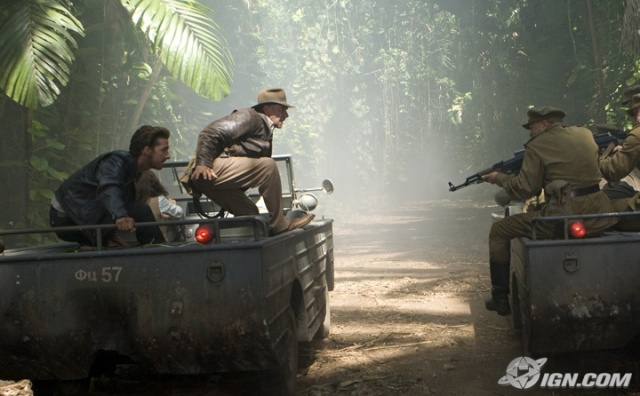 If the above sounds unnecessarily convoluted, that fits the tone of the movie, which has a tendency to get long-winded about things the others wisely kept simple. The Crystal Skull (or skulls, as it turns out) is given the most laborious backstory of any of the series’ MacGuffins, with both Indy and Spalko delivering swaths of exposition about it. The old movies had the right idea; a quick summary and move on. After all, the joy of any Indiana Jones film is not the destination, it’s the journey. The Crystal Skull, like the Ark of the Covenant, the Sankara stones, and the Holy Grail, is a plot device to move us from point A to point B and string the action sequences together. Also, while they’re an obvious choice for the bad guys given the Cold War 1950s setting, the Soviets are somewhat weaker villains than the Nazis. Even Steven Spielberg himself noted once that Nazis are so easy to use as villains because they are a virtually universal symbol of evil; the Soviets just don’t generate the same boo hiss effect. Spalko’s motives are a little murky; a bunch of vague rambling about psychic warfare, using the supposed vast combined mind-controlling power of the reunited skulls to take over the US without firing a shot (‘we will change you”, she says, “and the best part is, you won’t even know it’s happening’). The old movies kept the bad guys’ motives simple: power, world domination, eternal life. Spalko’s seem both underdeveloped and over explained.
If the above sounds unnecessarily convoluted, that fits the tone of the movie, which has a tendency to get long-winded about things the others wisely kept simple. The Crystal Skull (or skulls, as it turns out) is given the most laborious backstory of any of the series’ MacGuffins, with both Indy and Spalko delivering swaths of exposition about it. The old movies had the right idea; a quick summary and move on. After all, the joy of any Indiana Jones film is not the destination, it’s the journey. The Crystal Skull, like the Ark of the Covenant, the Sankara stones, and the Holy Grail, is a plot device to move us from point A to point B and string the action sequences together. Also, while they’re an obvious choice for the bad guys given the Cold War 1950s setting, the Soviets are somewhat weaker villains than the Nazis. Even Steven Spielberg himself noted once that Nazis are so easy to use as villains because they are a virtually universal symbol of evil; the Soviets just don’t generate the same boo hiss effect. Spalko’s motives are a little murky; a bunch of vague rambling about psychic warfare, using the supposed vast combined mind-controlling power of the reunited skulls to take over the US without firing a shot (‘we will change you”, she says, “and the best part is, you won’t even know it’s happening’). The old movies kept the bad guys’ motives simple: power, world domination, eternal life. Spalko’s seem both underdeveloped and over explained.
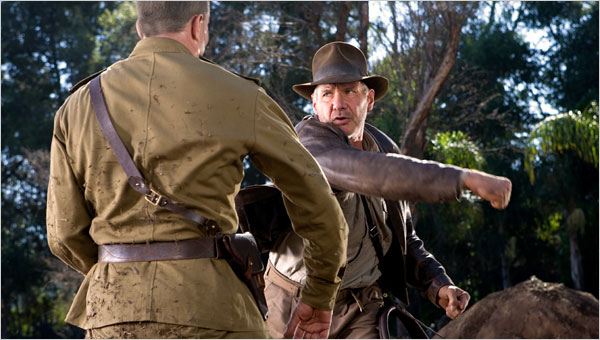 The problem isn’t the cast. Despite the nineteen years that have passed since he last donned the fedora, Harrison Ford slips back into Indiana Jones’ outfit and persona like an old, well-worn, comfortable shoe. Indiana Jones has always been the role Ford seems the most perfectly at home in, and he does an admirable job of slipping back into a character he last played in 1989. It’s telling of Ford’s enjoyment of the role that after a string of bored, autopilot performances in recent roles, he seems easily the most invigorated and enthusiastic here that he’s been at least since 1997’s Air Force One. Of course Ford is much older than in The Last Crusade, and the filmmakers don’t ignore the obvious fact that he is no longer a young man.He’s helped by a screenplay that acknowledges the gap of time and the actor/character’s age. Indy is still in the thick of the action, but the number of extreme stunts (at least those performed by Ford) has been scaled back a few notches, and he’s backed up by the largest group of sidekicks he’s ever had. This time the filmmakers allow Indy to acknowledge that he’s not a young man, and to be a little more of a team player.
The problem isn’t the cast. Despite the nineteen years that have passed since he last donned the fedora, Harrison Ford slips back into Indiana Jones’ outfit and persona like an old, well-worn, comfortable shoe. Indiana Jones has always been the role Ford seems the most perfectly at home in, and he does an admirable job of slipping back into a character he last played in 1989. It’s telling of Ford’s enjoyment of the role that after a string of bored, autopilot performances in recent roles, he seems easily the most invigorated and enthusiastic here that he’s been at least since 1997’s Air Force One. Of course Ford is much older than in The Last Crusade, and the filmmakers don’t ignore the obvious fact that he is no longer a young man.He’s helped by a screenplay that acknowledges the gap of time and the actor/character’s age. Indy is still in the thick of the action, but the number of extreme stunts (at least those performed by Ford) has been scaled back a few notches, and he’s backed up by the largest group of sidekicks he’s ever had. This time the filmmakers allow Indy to acknowledge that he’s not a young man, and to be a little more of a team player.
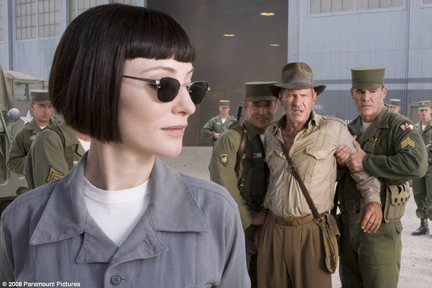 Shia LaBeouf is effective sidekick material. For the very busy young actor, this isn’t the kind of role that’s going to win him acting accolades, but like last year’s Transformers, it’s a further stepping stone toward stardom, and if nothing else LaBeouf, known so far as geeky boy-next-door types, shows that he can venture more into action hero territory without seeming ridiculous. Mutt compliments Indy well, mainly because he’s almost certainly the closest any sidekick has come to being an equal. He’s certainly a lot more appealing and a lot less irritating than Willie Scott or Short Round, and he can take care of himself in a scrape. It’s nice to see a familiar face other than Ford in the form of Karen Allen’s Marion (generally considered his worthiest love interest), but while Allen is throughout the second half of the film, and seems to be having fun returning to the series, she isn’t given much to do besides take the wheel during the lengthiest car chase, and resume her bickering with Indy for a short time before they get mushy like long-lost loves. It’s a bit disappointing that we don’t get any kind of smackdown between Marion and Spalko; in fact, the two women in the cast interact only fleetingly, and Marion doesn’t get to throw a punch. The supporting cast is talent-heavy with highly-regarded character actors- Cate Blanchett, Ray Winstone, John Hurt, Jim Broadbent- none of whom are given anything challenging. Cate Blanchett is underused, not given much to do besides stalking around looking stern, providing exposition about the Crystal Skull, threatening various characters with her rapier, and chasing Indy and company around the jungle, and is nowhere near Ronald Lacey’s Toht’s or Amrish Puri’s Mola Ram’s levels of nastiness. In fact, she’s disappointingly bland. Ray Winstone’s Mac is a plot device who switches allegiances whenever the script needs another twist. John Hurt is even more wasted, given nothing to do but wander around looking vacant and muttering unintelligibly. Even when he finally becomes lucid again, it’s too late for him to make an impression, and even then his utterances are less than profound; when Indy asks if the skulls’ owners have returned to outer space, Oxley replies ‘not space, but the space between spaces’. Huh? Part of what sometimes drags Crystal Skull down is the excess of supporting characters; what makes it worse is that they’re as flat as the pages they’re written on. Granted, we don’t come to Indiana Jones movies for deep character development, but previous supporting players, like Karen Allen’s Marion, Paul Freeman’s Belloq, Ronald Lacey’s Toht, and John Rhys-Davies’ Sallah all had a spark of something distinct about them that Spalko, Mac, and Oxley are missing.
Shia LaBeouf is effective sidekick material. For the very busy young actor, this isn’t the kind of role that’s going to win him acting accolades, but like last year’s Transformers, it’s a further stepping stone toward stardom, and if nothing else LaBeouf, known so far as geeky boy-next-door types, shows that he can venture more into action hero territory without seeming ridiculous. Mutt compliments Indy well, mainly because he’s almost certainly the closest any sidekick has come to being an equal. He’s certainly a lot more appealing and a lot less irritating than Willie Scott or Short Round, and he can take care of himself in a scrape. It’s nice to see a familiar face other than Ford in the form of Karen Allen’s Marion (generally considered his worthiest love interest), but while Allen is throughout the second half of the film, and seems to be having fun returning to the series, she isn’t given much to do besides take the wheel during the lengthiest car chase, and resume her bickering with Indy for a short time before they get mushy like long-lost loves. It’s a bit disappointing that we don’t get any kind of smackdown between Marion and Spalko; in fact, the two women in the cast interact only fleetingly, and Marion doesn’t get to throw a punch. The supporting cast is talent-heavy with highly-regarded character actors- Cate Blanchett, Ray Winstone, John Hurt, Jim Broadbent- none of whom are given anything challenging. Cate Blanchett is underused, not given much to do besides stalking around looking stern, providing exposition about the Crystal Skull, threatening various characters with her rapier, and chasing Indy and company around the jungle, and is nowhere near Ronald Lacey’s Toht’s or Amrish Puri’s Mola Ram’s levels of nastiness. In fact, she’s disappointingly bland. Ray Winstone’s Mac is a plot device who switches allegiances whenever the script needs another twist. John Hurt is even more wasted, given nothing to do but wander around looking vacant and muttering unintelligibly. Even when he finally becomes lucid again, it’s too late for him to make an impression, and even then his utterances are less than profound; when Indy asks if the skulls’ owners have returned to outer space, Oxley replies ‘not space, but the space between spaces’. Huh? Part of what sometimes drags Crystal Skull down is the excess of supporting characters; what makes it worse is that they’re as flat as the pages they’re written on. Granted, we don’t come to Indiana Jones movies for deep character development, but previous supporting players, like Karen Allen’s Marion, Paul Freeman’s Belloq, Ronald Lacey’s Toht, and John Rhys-Davies’ Sallah all had a spark of something distinct about them that Spalko, Mac, and Oxley are missing.
The only thing belying that Ford’s not as light on his feet as he used to be is the noticeably reduced number of major stunts he performs. That’s not to say he doesn’t do any, they’re just not the steady series he performed in previous outings. Ford’s best stunt work (if it’s all actually Ford, and it appears to be), is in the first third, especially during his warehouse escape, where he whips guns out of the bad guys’ hands, scrambles around over mountains of crates, swings from the rafters onto moving cars, and basically establishes that Indy is still Indy. It’s good that he gets this showcase, because after that Indy spends most of his time on the ground. There’s two car chases, and a fistfight, but not much swinging around (at least not by Indy). The next big action scene is a chase with Indy and Mutt on Mutt’s motorcycle tearing around and through Marshall College with Russkies in hot pursuit that ends up in the library. Maybe the movie’s most memorable action bit comes during this sequence, in which Indy is pulled off Mutt’s motorcycle and into the Russians’ car, and manages to fight his way out the other window and back onto the motorcycle. It combines nifty stunt work and clever action-comedy in the best tradition of Indiana Jones. Unfortunately, the movie is low on action for a while after that, and we spend time on Indy and Mutt trekking around Peru and too much talking about the Crystal Skull. The movie’s key action setpiece, a lengthy and somewhat disorganized car chase through the jungle , is hampered by too much CGI and too much silliness, including Mutt swinging through the trees like Tarzan. The earlier motorcycle chase has a nicely old-fashioned, no frills feel, and would have fit perfectly at home in any of the previous films, but the jungle chase does not. Despite some nifty stuntwork with Mutt and Spalko fencing on the tops of racing cars, this sequence still feels a pale shadow of the truck chase in Raiders, the tunnel race in Temple, or the tank duel in Last Crusade, and is indicative of the way the overall energy level is lower here.
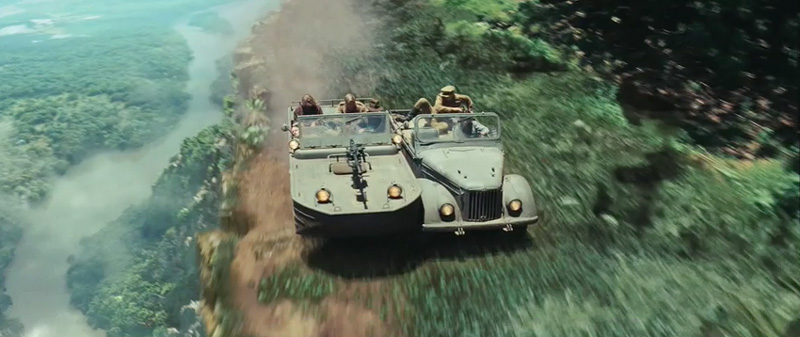 Spielberg and Lucas pull out all the stops to make this ‘feel’ like an Indiana Jones movie, relying in large part on the nostalgia many viewers will have for the original trilogy. There’s the old-fashioned Paramount mountain opening logo (one wonders if it’s a Lucas in-joke about lowering expectations when it turns into a prairie dog hill). We see pictures of Marcus Brody and Henry Jones Sr. Marshall College looks exactly the same. We revisit the same warehouse we saw at the end of Raiders, and the Ark of the Covenant makes a brief ‘cameo’. There’s the opening prologue action sequence featuring a tight spot and a daring Indy escape (although unlike the others, this one actually ties directly in with the main plot). There’s Indy’s fistfight with a hulking henchman, with Igor Jijikine filling in for the late Pat Roach. There’s also the obligatory creepy crawlies gross out moment, this time involving voracious red ants and borrowing a page from the man-eating beetles in The Mummy. The plot, while unnecessarily convoluted, very much follows the same blueprint as the others, particularly Raiders and Last Crusade: evil enemy military power seeks legendary object to tip scales in its favor, Indy and assorted sidekicks travel to remote regions racing against the baddies using clues in old legends and artifacts. There’s a ‘surprise revelation’ about a character that is unlikely to come as much of a shock for anyone who hasn’t been living under a rock for the past few months. The filmmakers also take advantage of the 1950s setting, starting right out with the opening, as Elvis Presley’s ‘You Ain’t Nothing But a Hound Dog’ blasts from radios, Howdy Doody is glimpsed on black-and-white television sets, Indy wanders onto atomic bomb test sites, his comeback when Spalko asks if he has any defiant last words is ‘I like Ike’ (this might go over some younger viewers’ heads, but some of the older audience members I attended with got a laugh out of it), and Mutt is introduced riding his Harley onto the screen dressed exactly like Marlon Brando in 1953’s The Wild One, down to the crooked cap. It has a lot of the familiar Indy ingredients, but there’s just not as much spark, and the energy and excitement level ebbs, with even the most exciting sequences not as exciting as what the series served up in the ’80s.
Spielberg and Lucas pull out all the stops to make this ‘feel’ like an Indiana Jones movie, relying in large part on the nostalgia many viewers will have for the original trilogy. There’s the old-fashioned Paramount mountain opening logo (one wonders if it’s a Lucas in-joke about lowering expectations when it turns into a prairie dog hill). We see pictures of Marcus Brody and Henry Jones Sr. Marshall College looks exactly the same. We revisit the same warehouse we saw at the end of Raiders, and the Ark of the Covenant makes a brief ‘cameo’. There’s the opening prologue action sequence featuring a tight spot and a daring Indy escape (although unlike the others, this one actually ties directly in with the main plot). There’s Indy’s fistfight with a hulking henchman, with Igor Jijikine filling in for the late Pat Roach. There’s also the obligatory creepy crawlies gross out moment, this time involving voracious red ants and borrowing a page from the man-eating beetles in The Mummy. The plot, while unnecessarily convoluted, very much follows the same blueprint as the others, particularly Raiders and Last Crusade: evil enemy military power seeks legendary object to tip scales in its favor, Indy and assorted sidekicks travel to remote regions racing against the baddies using clues in old legends and artifacts. There’s a ‘surprise revelation’ about a character that is unlikely to come as much of a shock for anyone who hasn’t been living under a rock for the past few months. The filmmakers also take advantage of the 1950s setting, starting right out with the opening, as Elvis Presley’s ‘You Ain’t Nothing But a Hound Dog’ blasts from radios, Howdy Doody is glimpsed on black-and-white television sets, Indy wanders onto atomic bomb test sites, his comeback when Spalko asks if he has any defiant last words is ‘I like Ike’ (this might go over some younger viewers’ heads, but some of the older audience members I attended with got a laugh out of it), and Mutt is introduced riding his Harley onto the screen dressed exactly like Marlon Brando in 1953’s The Wild One, down to the crooked cap. It has a lot of the familiar Indy ingredients, but there’s just not as much spark, and the energy and excitement level ebbs, with even the most exciting sequences not as exciting as what the series served up in the ’80s.
Another disappointing aspect is that the frantic second half never slows down enough for more than the most perfunctory ‘bonding’ between Indy and Mutt. There’s a missed opportunity to develop Indy and Mutt’s relationship into something like Indy’s relationship with his dad in The Last Crusade, another drawback of the excess of characters diluting the focus on the key relationship between Indy, Mutt, and Marion. Likewise, there’s still chemistry between Ford and Karen Allen, but their renewed relationship is given only the most perfunctory attention. One minute they’re bickering as though Raiders never ended, the next they’re getting mushy and giving each other adoring looks in between action sequences, which barely slow down long enough for them to catch a breath. This makes the epilogue in particular feel out of left field. It will undoubtedly provide satisfying closure for some Indy-Marion fans, but it doesn’t have enough leading up to it, and ends the movie on a somewhat ho-hum note. Spielberg and Lucas use CGI too liberally, throwing in some silly bits like reaction shots from animated prairie dogs (what, they couldn’t find any real prairie dogs?), and Mutt aping Tarzan (accompanied, as if the scene isn’t already goofy enough, by a small army of CGI monkies) at the lowest point of the jungle chase sequence. Indiana Jones movies have always been relatively tongue-in-cheek and not taken themselves terribly seriously, but these moments cross the line into too over-the-top attempts at comic relief.
Kingdom of the Crystal Skull isn’t unwatchable, but the freshness and energy of the original trilogy is sputtering at best. Harrison Ford still wears the fedora well, an underused Marion is better than no Marion, Shia LaBeouf is a welcome addition, and while the jungle chase gets a little carried away with CGI, . Nonetheless, the series is noticeably creaking with age here, and I think it’s time to Indy to hang up the whip.
**1/2
